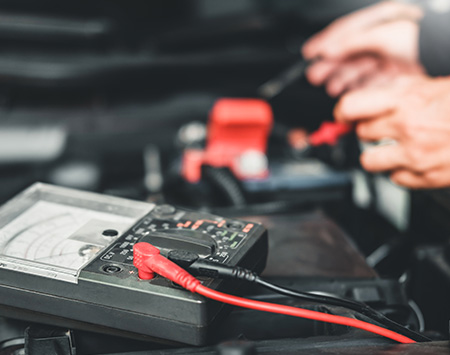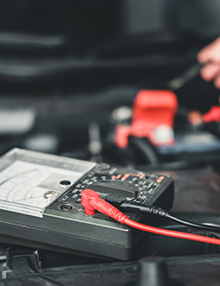The battery is the unsung hero of a car's mechanics. You probably never pay it a second thought, at least until it fails at the most inconvenient moment. If you want to avoid being stranded, it's good to test your battery regularly, checking whether it's still holding a charge or if it needs replacing. Here's what to do.
Before Testing: Important Safety Precautions
A car battery packs a lot of juice, so safety is extremely important. Before even opening the hood, turn on the ignition to make sure your car starts as normal. Then, with the engine still running, make sure your headlights and any sidelights are switched off. Also, turn off any other accessories, such as the radio, air conditioning, GPS and so on.
Be sure to switch off any devices that can still run with the engine off: you want no electricity flowing through the system at all. Once you've done all this, turn off the ignition again.
Finally, since lead acid batteries contain dangerously corrosive contents, it's a sensible idea to wear eye goggles and sturdy, waterproof gloves to protect you if the battery has a leak or other problem.
How to Test a Car Battery with a Multimeter
The simplest way to check your battery is to use an ordinary electrical multimeter. While this might be a little daunting if you've never done it before, it's a straightforward job.
- Set your multimeter to a low setting where it can accurately measure around 15 volts DC.
- After double-checking that the ignition is turned off, remove the cover from the battery's positive terminal.
- If you see any grease or corrosion, wipe it clear to ensure a good electrical contact with the multimeter.
- Do the same with the negative terminal.
- Connect the multimeter to the two terminals, with the red lead going to the positive one and the black to the negative.
- You should now have a voltage reading on your meter, and ideally it will be somewhere between 12.4V and 12.7V. This shows a healthy battery carrying a good charge.
- If the voltage is below 12.2V, it will need a recharge to bring it back up to level. Either use a charger for seriously low batteries, or take a drive on the highway for less severe cases.
- If it's higher than 12.9V, the battery is overcharged and needs the extra energy removed to prevent long-term damage. You can do this by switching your headlights onto the high beam setting until the voltage is back inside the ideal range.
How Do You Know if Your Car Battery is Dead?
A low reading doesn't necessarily mean you've got a bad or dead battery, but if it remains low after recharging or a sustained highway drive, it's a good idea to have it checked out by an expert.
Even though testing a car battery is straightforward, we realize that it's not something everyone will want to do. Instead, simply bring your car into your nearest Batteries Plus store and we can test it for you, completely free of charge, and help you find the right replacement if necessary. We’ll even make sure your old battery is recycled properly.

